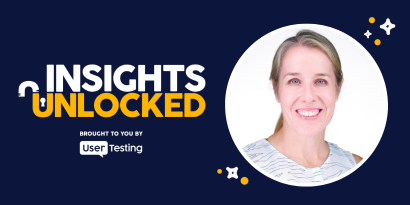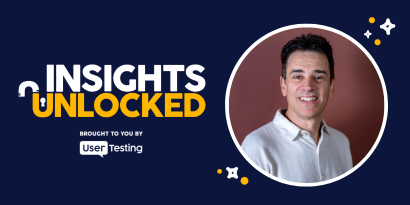
Episode 130 | August 12, 2024
Designing for Impact: Insights from Richard Dalton, Head of Design at Verizon
In this week’s Insights Unlocked, Verizon’s Richard Dalton shares his framework for designing sustainable customer experiences.
Designing for Impact: Insights from Richard Dalton, Head of Design at Verizon
In the latest episode of Insights Unlocked, Richard Dalton, Head of Design for Consumer at Verizon, shared invaluable insights on creating impactful user experiences (UX) within large organizations. This blog post delves into the key themes and ideas discussed in the podcast, providing actionable takeaways for design leaders and professionals.
Introduction to UX Design at Scale
Richard’s role at Verizon involves overseeing the design of all consumer-facing interactions, including apps, websites, and physical interactions and store experiences. He leads a team of 250 designers (and growing) who create human-centric experiences for over 100 million customers.
In this week’s Insights Unlocked, Richard shares his framework for designing sustainable customer experiences. He was interviewed at UXDX in New York, where he delivered his keynote “Structuring Teams and Portfolios for Success.”
Building Effective UX Design Structures
Richard emphasizes that hiring talented designers is only part of the equation. Organizations must also invest in creating internal design teams and supportive structures. This foundation enables the design of superior experiences for both employees and customers.
“You can't just hire a bunch of designers and say, ‘Build me an experience,’” Richard asserts. He emphasizes that effective UX design requires more than hiring talented designers; it necessitates building supportive structures and investing in internal design teams to enhance both employee and customer experiences.
“You can't just hire a bunch of designers and say, ‘Build me an experience,’” — Richard Dalton, Head of Design at Verizon
Richard's insights provide a valuable roadmap for design leaders aiming to elevate their UX strategy. Between money and the desired experience, he said, are steps along this “ziggurat of impact” that include:
- Taxonomy
- Measurement
- Portfolio
- Process
- People
The Power of Behavior-Based Metrics
Traditional metrics like Net Promoter Scores (NPS) can be too broad and non-specific. Richard advocates for behavior-based questions that align with customer satisfaction and dissatisfaction. These metrics provide more actionable insights, allowing organizations to fine-tune their user experiences.
Example Questions:
- What does a successful customer do in our product?
- What are the behaviors of a dissatisfied customer?
“NPS is a useful measure, but it doesn’t capture why someone is having an issue or why they like part of your experience,” Richard explained. “You need more specific measures that are much more actionable when you start to think about how to gauge the health of the experience.”
Richard references Jeff Gothelf’s approach which seeks to understand what successful customers do within a product. This method helps identify patterns, such as whether satisfied customers are sharing the product, buying more, or spending significant time using it.

“When somebody is happy, what are they doing, and how are they behaving?” asks Richard. “Are they sharing the product with other people? Are they buying more? Are they spending a long time in your product or a short amount of time in your product?”
Conversely, Richard also emphasizes the importance of understanding the behaviors of dissatisfied customers. “What is a dissatisfied customer doing in our product?,” he said. “Are they leaving quickly? Are they calling customer support because they can’t figure out how to do it online?” These insights are crucial for making precise improvements to the user experience.
By shifting the focus to behavior-based metrics, Richard believes companies can obtain clearer, more actionable data to enhance their products and services. “Specific measures are much more actionable,” he noted, “and they allow you to start thinking about how to truly improve the user experience.”
Extending UX Beyond Digital Interfaces
UX design is often misconceived as limited to digital elements like colors, buttons and navigation. However, Richard explains that every department within an organization, from legal to procurement, impacts the overall customer experience. A holistic approach ensures all decisions consider their effect on customers.
The way you hire, train, and set policies can have a domino effect on the customer experience. — Richard Dalton, Head of Design at Verizon
“Design of the customer experience can be influenced by everybody in an organization,” he said. “The way that you bring people in and train people, how you hire people, the legal decisions you make, the policies that you set, pricing rules, business processes, procurement.”
“Everything that you might think of in the bottom of the iceberg of a huge organization can have this kind of domino effect on the customer experience at the top. And I think that it's our responsibility as design teams to not just try and make the top of the iceberg better, but to try and make everybody in the organization aware of the impact that they are having.”
Fostering a Customer-Aware Culture
Richard envisions a future where all employees, not just designers, understand and prioritize customer impact. He dreams of seeing policy discussions centered around customer effects, even without a designer present.
“It's my dream someday to walk past a meeting room with an open doorway in any organization and to see a group of people in there, without a designer in there, having a conversation about, ‘hey, we're about to make this policy decision. What's the impact on the customer that that's going to have?,’” Richard said. “When you get to that point, you truly have what I would call a customer-aware organization.”
The Importance of Visualization and Communication
Inspired by Edward Tufte's design principles, Richard stresses the value of visualizing complex information on a single page. This approach facilitates better comparisons and decision-making, helping organizations communicate more effectively.
"If you're trying to have people compare two things, don't have them turn the page between the things because then they're flipping the page back and forth," Richard said. "Put them next to each other, regardless of how big the piece of paper needs to be."
"And that's where I think we can use our design skills internally in our organizations to be able to simplify the complex and communicate things way beyond making a web page or making a mobile app."
Verizon's Design Team Expansion
Richard announces Verizon’s plans to hire 180 designers. This initiative aims to increase full-time employee representation in the design team, reducing reliance on contractors and agencies.
"We're going to be getting to 70% representation of full-time employees probably sometime next year, maybe 50%, 55% by the end of this year," Richard said. "And we're building out the team. So, yeah, it's exciting times."
Conclusion
This episode of Insights Unlocked with Richard Dalton offers valuable perspectives on UX design and its broader implications within organizations. By focusing on behavior-based metrics, fostering a customer-aware culture, and visualizing complex data, design leaders can significantly enhance their user experience strategies.
Episode links
- Richard Dalton on LinkedIn
- Verizon's careers page
- BLOG: A primer to design systems: Making yours in 5 steps
- GUIDE: The ultimate guide to user-centric product design










